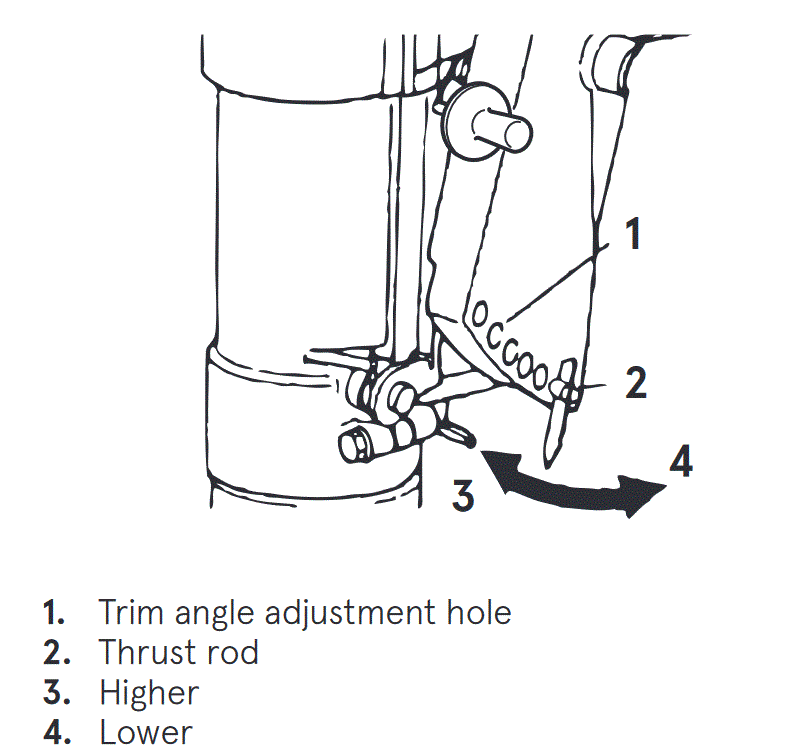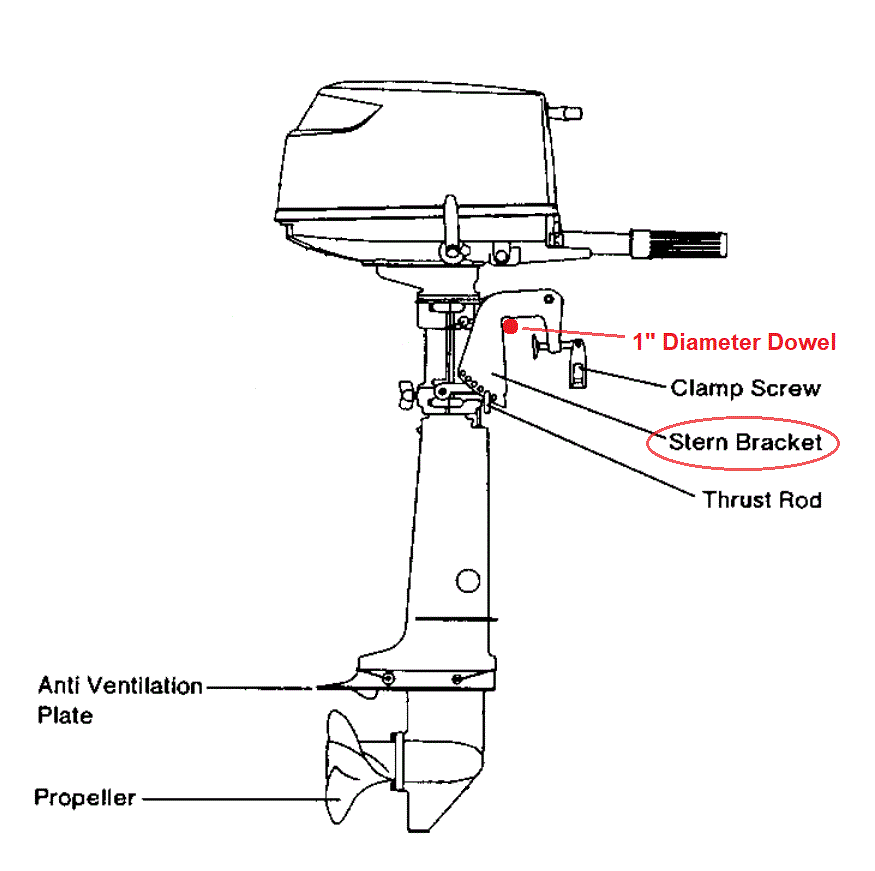Trim Your Small Boat For Maximal Speed
Updated December 11, 2023
The above diagram of the parts of a portable outboard motor will serve to explain the steps we recommend, and those that we deem “advanced”, namely optional, as their contribution to speed improvements is not guaranteed.
The Problem To Overcome
Typically, the stern of a small boat weighs more than its bow, because its motor is mounted at its stern, and the driver sits next to it.
The combined weight of the motor and driver pushes the stern downward, and consequently, the bow upward. The faster the boat goes, the lower the stern and the higher the bow will be, because of the wave that the boat’s hull generates while it moves in the water.
The problem with this tilted position of the boat is that it tends to generate more resistance from the water than if the boat is level, with its bow and stern at the same height from the surface of the water. The result of this increased resistance is a decrease in the boat’s speed.
Therefore, the challenge of the small boat’s owner is to get their boat to a position that’s more level, namely horizontal, while it goes in the water at full throttle.
Basic Steps
Before Trimming
Outfit The Motor With The Highest Pitch Propeller –
The higher the propeller’s pitch, the faster it can drive the boat.
One of the reasons why we recommend the Tohatsu and Mercury portable outboards is because they can be outfitted with the highest pitch propellers for their size. For example, the 6 HP outboard that these two companies offer comes with an 8″ pitch propeller, which is fine for a boat that’s as lightweight as the S4, and it can take a 9″ pitch propeller.
For optimal performance of the propeller, Outboard Motor Manufacturers recommend to have the Anti Ventilation Plate (see above diagram) between 1″ and 2″ below the surface. Higher than this would loss of power due to ventilation, namely air mixing with the water in which the propeller rotates, and lower would cause more drag.
1. Adjust The Motor’s Trim Angle
This is done by inserting the horizontal metal pin called “Thrust Rod” in the lowest pair of holes in the Stern Bracket, namely the pair of holes that’s closest to the boat’s transom. This will force the propeller forward, and the bow downward when the boat is moving.

2. Drive From The Middle Of The Cockpit, Not From The Stern
A typical 6 HP outboard motor weighs around 60 lbs, and there is no way to attach it elsewhere but to the transom. In comparison, a typical driver can weigh from double this weight to six times as much, that is from 120 lb to 360 lbs.
This means that by moving the driver from the stern forward, towards the middle of the boat, we will considerably reduce the downward pressure on the stern. This can be achieved by outfitting the motor with a long, U-jointed Tiller Extension. This accessory is a long tube that features a joint (articulation), and it allows the driver to sit or stand at a significant distance from the motor, and drive comfortably while facing forward instead of facing sideways.
U-jointed tiller extensions are sold online. Using a long U-jointed tiller extension will allow you to sit, or stand a few feet forward, towards the middle of the cockpit, and thus help make the boat completely level, and therefore faster.

3. Place a Horizontal Dowel In The Motor’s Stern Bracket
See diagram of the outboard motor’s parts at the top of this page: The 3/4″ or 1″ diameter wooden dowel is represented by a red dot. It is placed inside the rounded corner of the Stern Bracket, and it is held in place by the pressure of the clamp screws on this bracket.
Such dowel forces the motor into an even more aggressive trim angle than the Thrust Rod alone allows for.
This can yield positive results on flat water, but driving in choppy water and waves with the bow pointing too low can cause the boat to slam into incoming waves, and dive in front of following waves, instead of going over them.
Bottom line: Think twice before using such a dowel.
4. Outfitting The Propeller Shaft With a Hydrofoil
A hydrofoil generates upward thrust on the motor, and thus forces the stern upward and the bow downward. It works, typically, but not necessarily in this case. The problem is that being fully submerged at all times, a hydrofoil is an element that’s not very efficient, since it generates drag whenever the boat is moving, especially at higher speeds. Since the motor on your S4 is not particularly powerful, you don’t have excess power to allocate to overcoming extra drag.
Therefore, in our view, if you trim the motor aggressively and you drive it from its middle instead of from its stern (see steps 1 – 3), there would be little to gain in speed terms from outfitting the motor with a hydrofoil, and therefore, we do not recommend it.
5. Trim Tab/s
Trim tabs generate a lot of drag, and therefore, they can work only in boats with motors that are powerful enough to provide the extra power needed to overcome this extra drag. Since this is not the case with motors that power your S4 who’s powered by small motors, trim tabs would slow you down, and we recommend not using them.
6. Add Weight To The Bow
This may work, but only if the driver is very lightweight, and the fact that they drive from the middle of the boat doesn’t yield much in terms of alleviating the stern and pushing the bow downward. Generally speaking, adding weight to the bow is not a good idea, because the hull of a heavier boat displaces more water, and therefore generates more resistance when it moves through it, and more resistance means less speed.
Do you have any questions for us?



And what is the top speed that one may aspire to reach with a 6 HP 4-stroke outboard, after a successful trimming? –
15 mph seems like a realistic number.
BTW, due to the small size and weight of the S4, and the low power of the motor, the driver’s weight could have a noticeable impact on the boat’s speed.
The current speed record for the S4 is held by Captain Larry Jarboe, from Key Largo, who achieved it while he was driving his S4 with an old, lightweight, 2-cycle 10 HP motor that probably didn’t produce this amount of power.